The Spatiotemporal Variability of Evapotranspiration and Its Response to Climate Change and Land Use/Land Cover Change in the Three Gorges Reservoir
Abstract
:1. Introduction
2. Materials and Methods
2.1. Study Area
2.2. Data
2.3. Methods
2.3.1. Description of CLM4.5
2.3.2. Experimental Design
2.3.3. Trend Analysis
2.3.4. k-Means Clustering Algorithm
- (1)
- k data were randomly selected from all data samples as the initial cluster center.
- (2)
- Calculate the distance of other data to each cluster center and divide them into the nearest cluster.
- (3)
- The center points of all sample data in each cluster are used to represent each cluster center.
- (4)
- Repeat steps (2) and (3) until the center point of each cluster is unchanged or reaches the set number of iterations.
3. Results
3.1. Trend in LUCC and Cliamte Change
3.1.1. Variation in Land Use/Land Cover
3.1.2. Variation in Climatic Factors
3.2. Model Validation
3.3. Spatiotemporal Variability of ET
3.3.1. Variation in ET
3.3.2. ET Response to Climate Change and LUCC
4. Discussion
4.1. Modeling Uncertainties
4.2. Variation in ET Components and Driving Factors
5. Conclusions
- (1)
- During 1993–2013, the TGR region had witnessed a warm and dry climate trend with the decrease of precipitation, wind speed and relative humidity and the increase in temperature. At the same time, the construction of the TGR region and the implementation of the policy of returning farmland to forests (grass) led to a reduction in cropland and an increase in forests, grasslands, water bodies and urban areas. In this context, the mean annual ET of the TGR region increased at a rate of 2.11 mm/year.
- (2)
- The CLM4.5 land surface model was suitable to model the ET in the TGR region. The results from the four evaluation indexes showed that the CLM4.5 model slightly underestimated the ET of the TGR region. It is, therefore, highly recommended that a new module considering the reservoir operation process and the dynamic changes of vegetation should be integrated into the CLM4.5 model and more precise data should be used in the future to improve the accuracy of the simulation performance.
- (3)
- The cluster analysis showed that two categories can better reflect the climatic conditions of TGR. The ET of similar climatic conditions is not necessarily similar, and LUCC can also affect ET. The LUCC in high altitude regions make the cluster analysis results of ET significantly different from other regions.
- (4)
- The mean annual ET of the TGR was 606 mm which increased by 13.76 mm after impoundment. The increase due to climate change was 9.61 mm, while the increase due to LUCC was 4.15 mm. Spatially, vegetation transpiration accounted for the largest proportion of ET. The decrease in relative humidity was the most important factor for the increase in vegetation transpiration, while the increase in ground evaporation was primarily due to the increase in wind speed in the center of the TGR region. The change in the PFTs, caused by urbanization and the construction of the TGR region, was the main factor causing the variation in ET in the water bodies, urban areas and high-altitude regions of the TGR region. These combined effects led to the increase in ET after impoundment and showed different spatial distribution characteristics in the TGR region.
Author Contributions
Funding
Acknowledgments
Conflicts of Interest
References
- Jung, M.; Reichstein, M.; Ciais, P.; Seneviratne, S.I.; Sheffield, J.; Goulden, M.L.; Bonan, G.; Cescatti, A.; Chen, J.Q.; de Jeu, R.; et al. Recent decline in the global land evapotranspiration trend due to limited moisture supply. Nature 2010, 467, 951–954. [Google Scholar] [CrossRef] [PubMed]
- Vörösmarty, C.J.; Green, P.; Salisbury, J.; Lammers, R.B. Global water resources: Vulnerability from climate change and population growth. Science 2000, 289, 284–288. [Google Scholar]
- Shukla, J.; Mintz, Y. Influence of Land-Surface Evapotranspiration on the Earth’s Climate. Science 1982, 215, 1498–1501. [Google Scholar] [CrossRef]
- Pan, S.F.; Tian, H.Q.; Dangal, S.R.; Yang, Q.C.; Yang, J.; Lu, C.Q.; Tao, B.; Ren, W.; Ouyang, Z.Y. Response of global terrestrial evapotranspiration to climate change and increasing atmospheric CO2 in the 21st century. Earth’s Future 2015, 3, 15–35. [Google Scholar] [CrossRef]
- Mononen, L.; Auvinen, A.P.; Ahokumpu, A.L.; Rönkä, M.; Aarras, N.; Tolvanen, H.; Kamppinen, M.; Viirret, E.; Kumpula, T.; Vihervaara, P. National ecosystem service indicators: Measures of social-ecological sustainability. Ecol. Indic. 2016, 61, 27–37. [Google Scholar] [CrossRef]
- Tang, Q.; Bao, Y.H.; He, X.B.; Fu, B.J.; Collins, A.L.; Zhang, X.B. Flow regulation manipulates contemporary seasonal sedimentary dynamics in the reservoir fluctuation zone of the Three Gorges Reservoir, China. Sci. Total Environ. 2016, 548, 410–420. [Google Scholar] [CrossRef]
- Huang, C.B.; Huang, X.; Peng, C.H.; Zhou, Z.X.; Teng, M.J.; Wang, P.C. Land use/cover change in the Three Gorges Reservoir area, China: Reconciling the land use conflicts between development and protection. Catena 2019, 175, 388–399. [Google Scholar] [CrossRef]
- Reder, A.; Rianna, G.; Vezzoli, R.; Mercogliano, P. Assessment of possible impacts of climate change on the hydrological regimes of different regions in China. Adv. Clim. Chang. Res. 2016, 7, 169–184. [Google Scholar] [CrossRef]
- Huo, Z.L.; Dai, X.Q.; Feng, S.Y.; Kang, S.Z.; Huang, G.H. Effect of climate change on reference evapotranspiration and aridity index in arid region of China. J. Hydrol. 2013, 492, 24–34. [Google Scholar] [CrossRef]
- Gong, L.B.; Xu, C.Y.; Chen, D.L.; Halldin, S.; Chen, Y.D. Sensitivity of the Penman-Monteith reference evapotranspiration to key climatic variables in the Changjiang (Yangtze River) basin. J. Hydrol. 2006, 329, 620–629. [Google Scholar] [CrossRef]
- Xu, C.Y.; Gong, L.B.; Jiang, T.; Chen, D.L.; Singh, V.P. Analysis of spatial distribution and temporal trend of reference evapotranspiration and pan evaporation in Changjiang (Yangtze River) catchment. J. Hydrol. 2006, 327, 81–93. [Google Scholar] [CrossRef]
- Fan, J.L.; Wu, L.F.; Zhang, F.C.; Xiang, Y.Z.; Zheng, J. Climate change effects on reference crop evapotranspiration across different climatic zones of China during 1956-2015. J. Hydrol. 2016, 542, 923–937. [Google Scholar] [CrossRef]
- Bosch, J.M.; Hewlett, J.D. A review of catchment experiments to determine the effect of vegetation changes on water yield and evapotranspiration. J. Hydrol. 1982, 55, 3–23. [Google Scholar] [CrossRef]
- Gao, G.; Chen, D.L.; Xu, C.Y.; Simelton, E. Trend of estimated actual evapotranspiration over China during 1960-2002. J. Geophys. Res. 2007, 112, D11120. [Google Scholar] [CrossRef]
- French, A.N.; Hunsaker, D.J.; Thorp, K.R. Remote sensing of evapotranspiration over cotton using the TSEB and METRIC energy balance models. Remote Sens. Environ. 2015, 158, 281–294. [Google Scholar] [CrossRef]
- Liu, M.L.; Tian, H.Q.; Chen, G.S.; Ren, W.; Zhang, C.; Liu, J.Y. Effects of land-use and land-cover change on evapotranspiration and water yield in China during 1900-2000. J. Am. Water Resour. Assoc. 2008, 44, 1193–1207. [Google Scholar] [CrossRef]
- Olchev, A.; Ibrom, A.; Priess, J.; Erasmi, S.; Leemhuis, C.; Twele, A.; Radler, K.; Kreilein, H.; Panferov, O.; Gravenhorst, G. Effects of land-use changes on evapotranspiration of tropical rain forest margin area in Central Sulawesi (Indonesia): Modelling study with a regional SVAT model. Ecol. Model. 2008, 212, 131–137. [Google Scholar] [CrossRef]
- Tian, H.Q.; Chen, G.S.; Liu, M.L.; Zhang, C.; Sun, G.; Lu, C.Q.; Xu, X.F.; Ren, W.; Pan, S.F.; Chappelka, A. Model estimates of net primary productivity, evapotranspiration, and water use efficiency in the terrestrial ecosystems of the southern United States during 1895–2007. For. Ecol. Manag. 2010, 259, 1311–1327. [Google Scholar] [CrossRef]
- Wang, K.C.; Dickinson, R.E. A review of global terrestrial evapotranspiration: Observation, modeling, climatology, and climatic variability. Rev. Geophys. 2012, 50, RG2005. [Google Scholar]
- Zhang, L.; Nan, Z.T.; Yu, W.J.; Zhao, Y.B.; Xu, Y. Comparison of baseline period choices for separating climate and land use/land cover change impacts on watershed hydrology using distributed hydrological models. Sci. Total Environ. 2018, 622–623, 1016–1028. [Google Scholar] [CrossRef] [PubMed]
- Bai, M.; Mo, X.G.; Liu, S.X.; Hu, S. Contributions of climate change and vegetation greening to evapotranspiration trend in a typical hilly-gully basin on the Loess Plateau, China. Sci. Total Environ. 2019, 657, 325–339. [Google Scholar] [CrossRef] [PubMed]
- Yuan, W.P.; Liu, S.G.; Yu, G.R.; Bonnefond, J.M.; Chen, J.Q.; Davis, K.; Desai, A.R.; Goldstein, A.H.; Gianelle, D.; Rossi, F.; et al. Global estimates of evapotranspiration and gross primary production based on MODIS and global meteorology data. Remote Sens. Environ. 2010, 114, 1416–1431. [Google Scholar] [CrossRef] [Green Version]
- Stoy, P.C.; Katul, G.G.; Siqueira, M.B.; Juang, J.Y.; Novick, K.A.; McCarthy, H.R.; Oishi, A.C.; Uebelherr, J.M.; Kim, H.S.; Oren, R. Separating the effects of climate and vegetation on evapotranspiration along a successional chronosequence in the southeastern US. Glob. Chang. Biol. 2006, 12, 2115–2135. [Google Scholar] [CrossRef] [Green Version]
- Li, G.; Zhang, F.M.; Jing, Y.S.; Liu, Y.B.; Sun, G. Response of evapotranspiration to changes in land use and land cover and climate in China during 2001-2013. Sci. Total Environ. 2017, 596–597, 256–265. [Google Scholar] [CrossRef] [PubMed]
- Chen, Y.Y.; Yang, K.; He, J.; Qin, J.; Shi, J.C.; Du, J.Y.; He, Q. Improving land surface temperature modeling for dry land of China. J. Geophys. Res. 2011, 116, D20104. [Google Scholar] [CrossRef]
- Yang, K.; He, J.; Tang, W.J.; Qin, J.; Cheng, C.C. On downward shortwave and longwave radiations over high altitude regions: Observation and modeling in the Tibetan Plateau. Agric. For. Meteorol. 2010, 150, 38–46. [Google Scholar] [CrossRef]
- Ran, Y.H.; Li, X.; Lu, L.; Li, Z.Y. Large-scale land cover mapping with the integration of multi-source information based on the Dempster-Shafer theory. Int. J. Geogr. Inf. Sci. 2011, 26, 169–191. [Google Scholar] [CrossRef]
- Friedl, M.A.; McIver, D.K.; Hodges, J.C.; Zhang, X.Y.; Muchoney, D.; Strahler, A.H.; Woodcock, C.E.; Gopal, S.; Schneider, A.; Cooper, A.; et al. Global land cover mapping from MODIS: Algorithms and early results. Remote Sens. Environ. 2002, 83, 287–302. [Google Scholar] [CrossRef]
- Friedl, M.A.; Sulla-Menashe, D.; Tan, B.; Schneider, A.; Ramankutty, N.; Sibley, A.; Huang, X.M. MODIS Collection 5 global land cover: Algorithm refinements and characterization of new datasets. Remote Sens. Environ. 2010, 114, 168–182. [Google Scholar] [CrossRef]
- Bonan, G.B.; Levis, S.; Kergoat, L.; Oleson, K.W. Landscapes as patches of plant functional types: An integrating concept for climate and ecosystem model. Glob. Biogeochem. Cycles 2002, 16, 5-1–5-23. [Google Scholar] [CrossRef]
- Shangguan, W.; Dai, Y.J.; Liu, B.Y.; Zhu, A.X.; Duan, Q.Y.; Wu, L.Z.; Ji, D.Y.; Ye, A.Z.; Yuan, H.; Zhang, Q.; et al. A China data set of soil properties for land surface modeling. J. Adv. Model. Earth Syst. 2013, 5, 212–224. [Google Scholar] [CrossRef]
- Mu, Q.Z.; Heinsch, F.A.; Zhao, M.S.; Running, S.W. Development of a global evapotranspiration algorithm based on MODIS and global meteorology data. Remote Sens. Environ. 2007, 111, 519–536. [Google Scholar] [CrossRef]
- Mu, Q.Z.; Zhao, M.S.; Running, S.W. Improvements to a MODIS global terrestrial evapotranspiration algorithm. Remote Sens. Environ. 2011, 115, 1781–1800. [Google Scholar] [CrossRef]
- Oleson, K.; Lawrence, D.; Bonan, G.; Drewniak, B.; Huang, M.; Koven, C.; Levis, S.; Li, F.; Riley, W.; Subin, Z.; et al. Technical Description of Version 4.5 of the Community Land Model (CLM), 1st ed.; National Center for Atmospheric Research: Boulder, CO, USA, 2013; pp. 1–11. [Google Scholar]
- Hurrell, J.W.; Holland, M.M.; Gent, P.R.; Ghan, S.; Kay, J.E.; Kushner, P.J.; Lamarque, J.F.; Large, W.G.; Lawrence, D.; Lindsay, K.; et al. The community earth system model: A framework for collaborative research. Bull. Am. Meteorol. Soc. 2013, 94, 1339–1360. [Google Scholar] [CrossRef]
- Lindsay, K.; Bonan, G.B.; Doney, S.C.; Hoffman, F.M.; Lawrence, D.M.; Long, M.C.; Mahowald, N.M.; Moore, J.K.; Randerson, J.T.; Thornton, P.E. Preindustrial-control and twentieth-century carbon cycle experiments with the earth system model CESM1 (BGC). J. Clim. 2014, 27, 8981–9005. [Google Scholar] [CrossRef]
- Jia, B.H.; Wang, Y.Y.; Xie, Z.H. Responses of the terrestrial carbon cycle to drought over China: Modeling sensitivities of the interactive nitrogen and dynamic vegetation. Ecol. Model. 2018, 368, 52–68. [Google Scholar] [CrossRef]
- Lawrence, D.M.; Thornton, P.E.; Oleson, K.W.; Bonan, G.B. The partitioning of evapotranspiration into transpiration, soil evaporation, and canopy evaporation in a GCM: Impacts on land-atmosphere interaction. J. Hydrometeorol. 2007, 8, 862–880. [Google Scholar] [CrossRef]
- Kool, D.; Agam, N.; Lazarovitch, N.; Heitman, J.L.; Sauer, T.J.; Ben-Gal, A. A review of approaches for evapotranspiration partitioning. Agric. For. Meteorol. 2014, 184, 56–70. [Google Scholar] [CrossRef]
- Nash, J.E.; Sutcliffe, J.V. River flow forecasting through conceptual models part I–A discussion of principles. J. Hydrol. 1970, 10, 282–290. [Google Scholar] [CrossRef]
- Gupta, H.V.; Sorooshian, S.; Yapo, P.O. Status of automatic calibration for hydrologic models: Comparison with multilevel expert calibration. J. Hydrol. Eng. 1999, 4, 135–143. [Google Scholar] [CrossRef]
- Box, J.F. Guinness, Gosset, Fisher, and small samples. Stat. Sci. 1987, 2, 45–52. [Google Scholar] [CrossRef]
- MacQueen, J. Some methods for classification and analysis of multivariate observations. Proceedings of Berkeley Symposium on Mathematical Statistics Probability, Berkeley, CA, USA, 21 June 1967. [Google Scholar]
- Monteith, J. Evaporation and the Environment, 1st ed.; Cambridge University Press: Cambridge, UK, 1965; pp. 205–234. [Google Scholar]
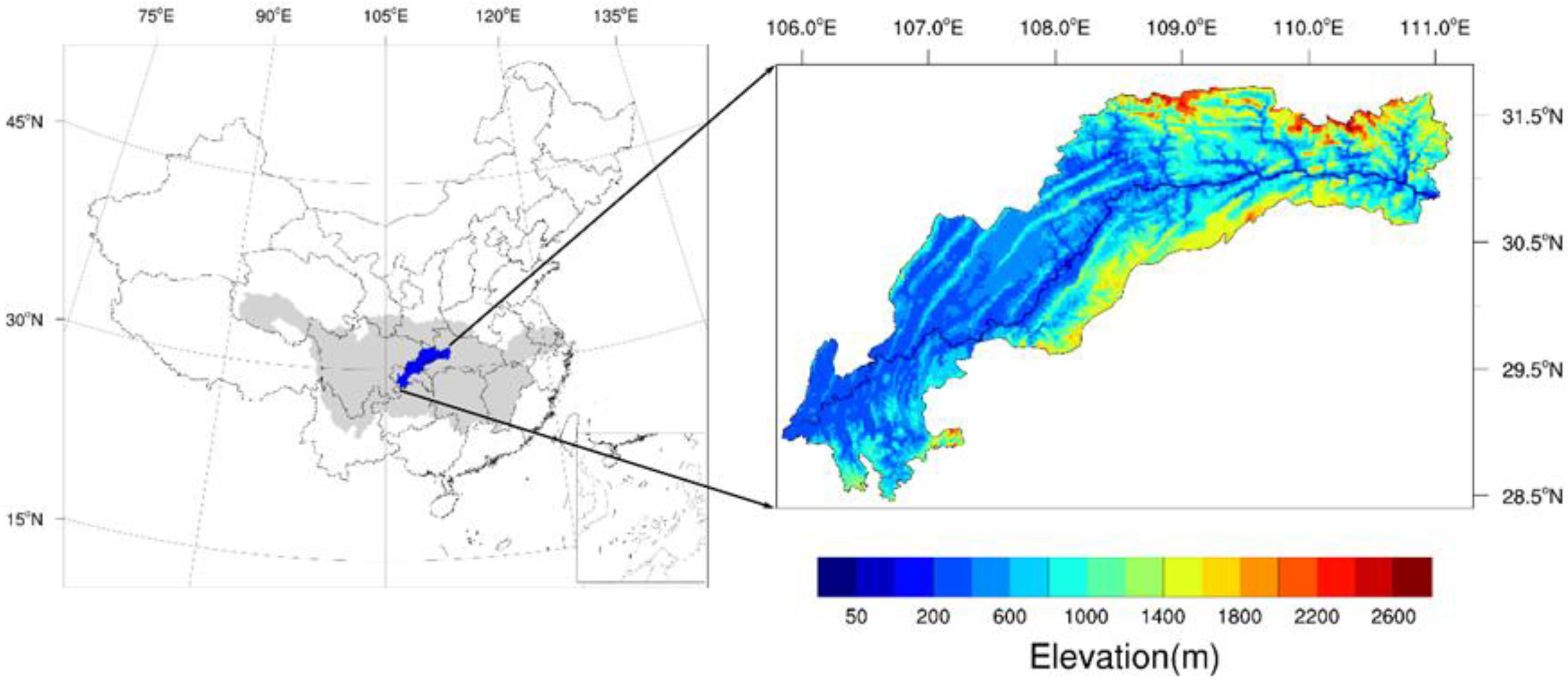
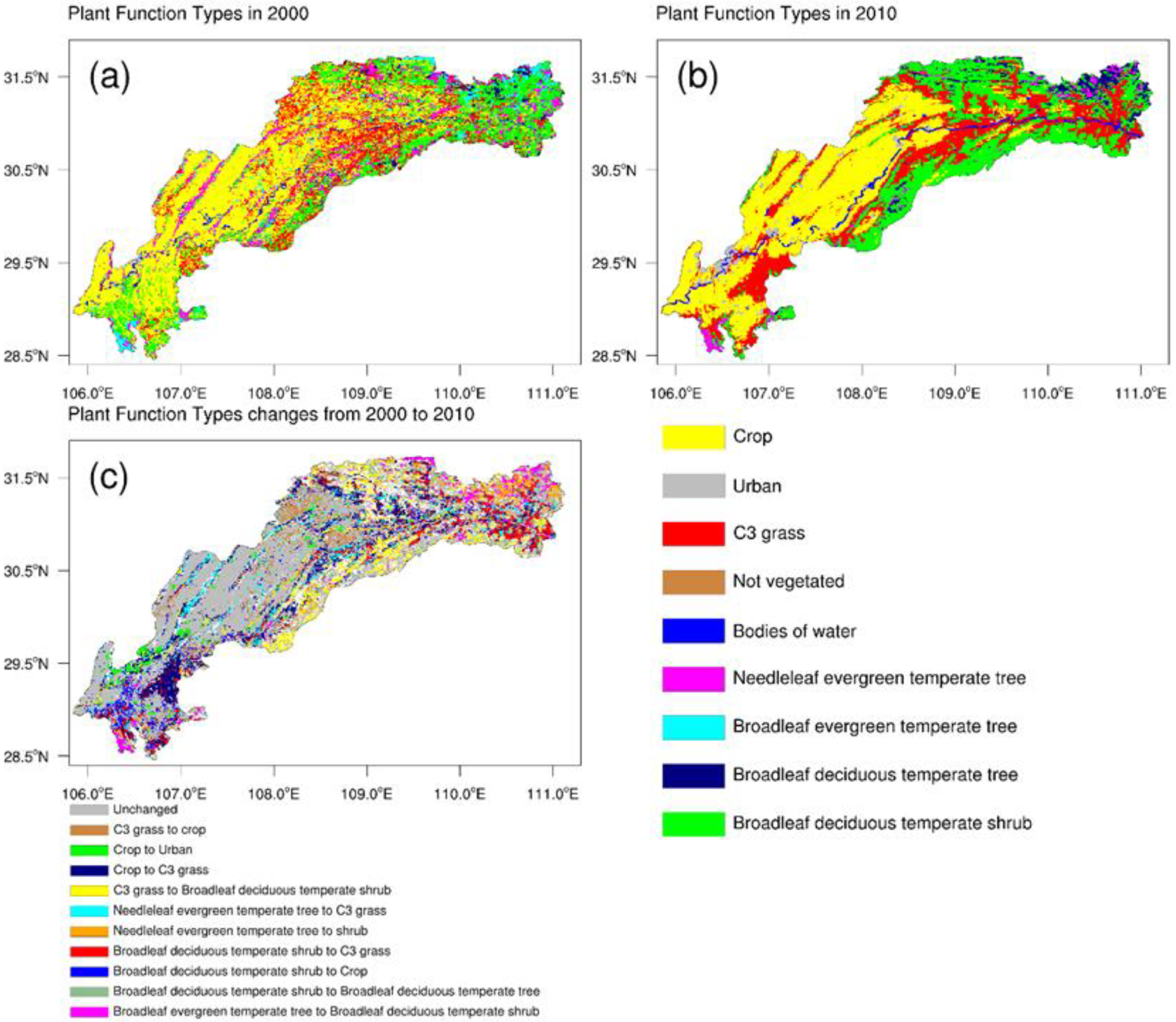


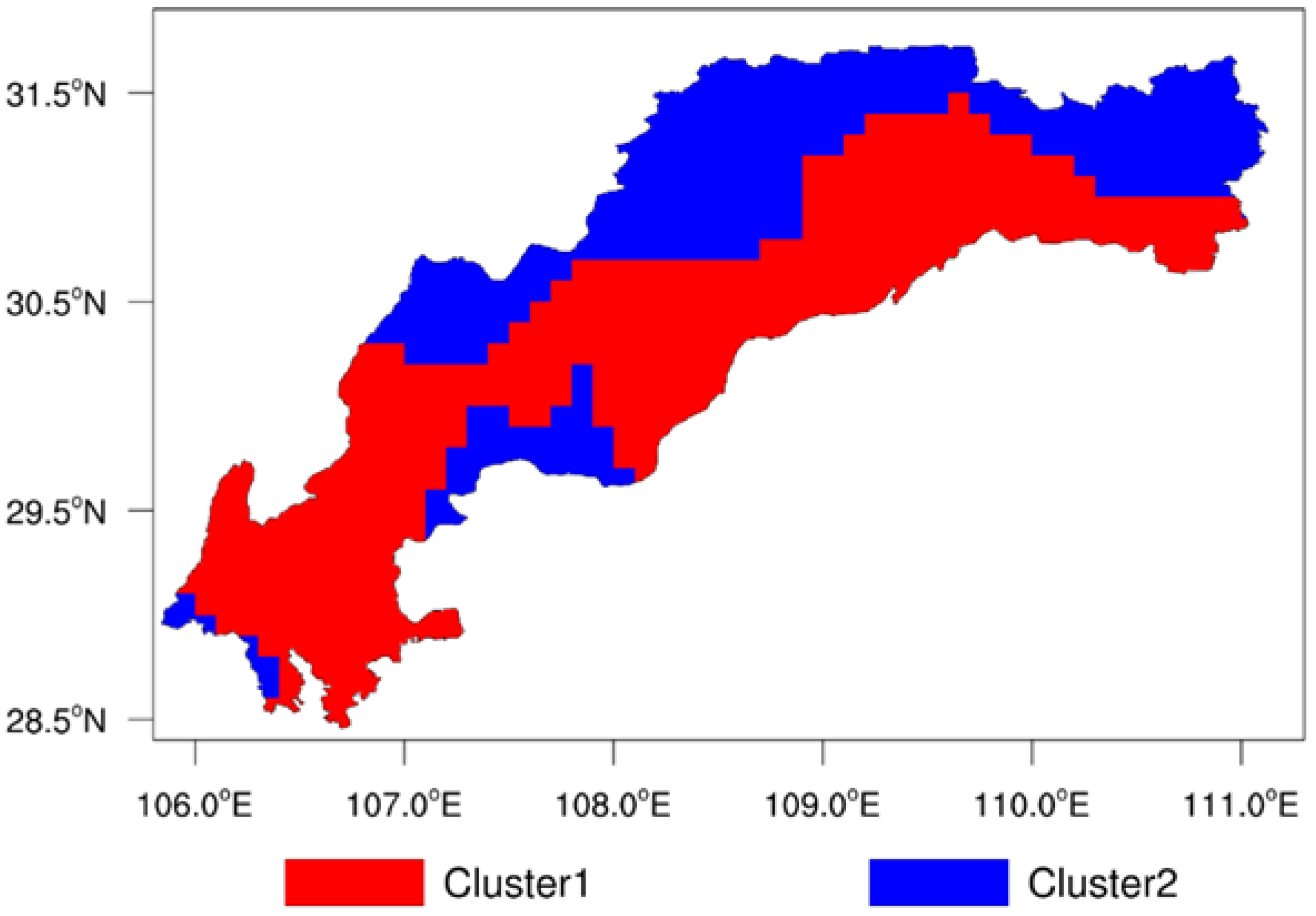
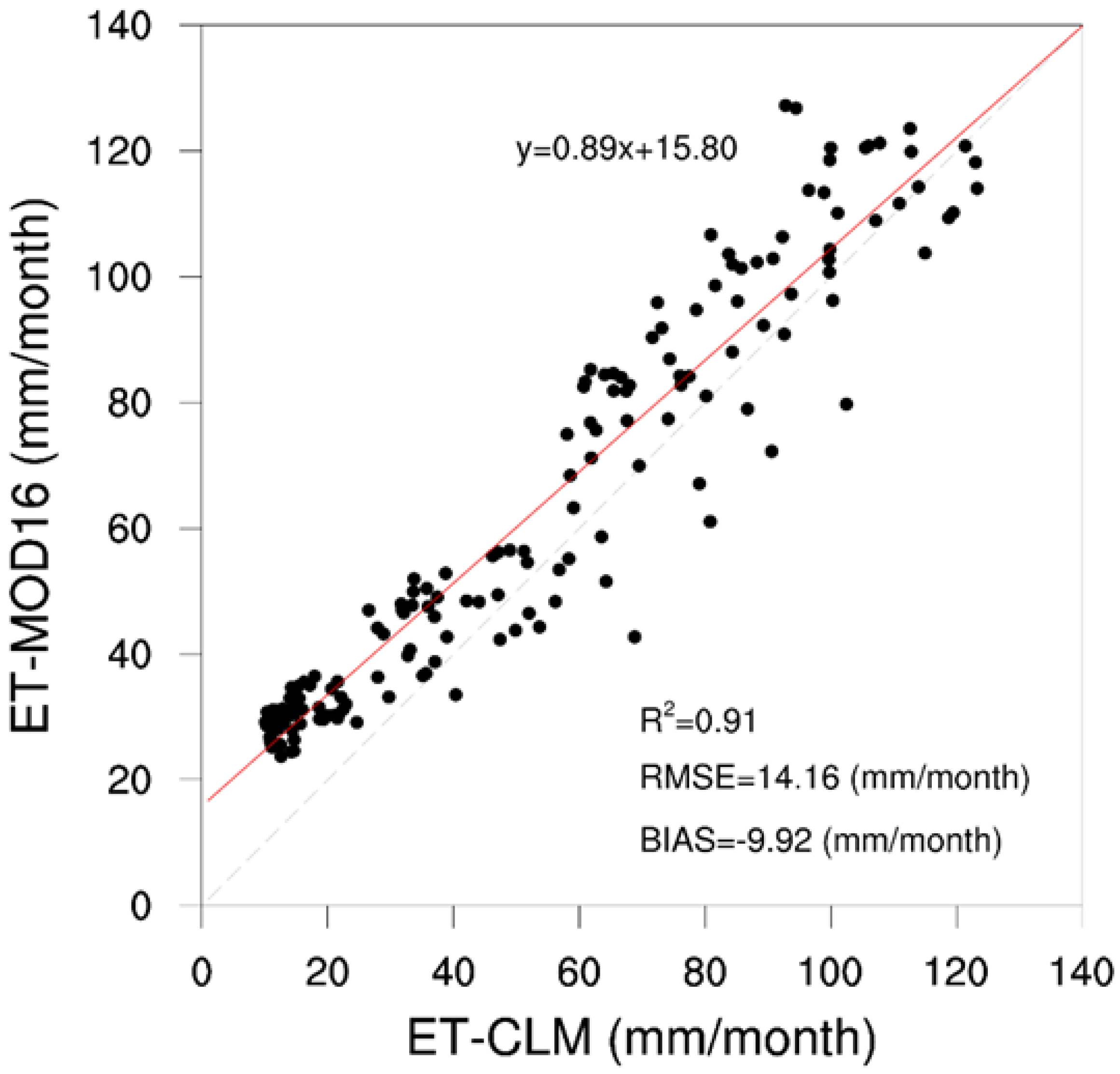


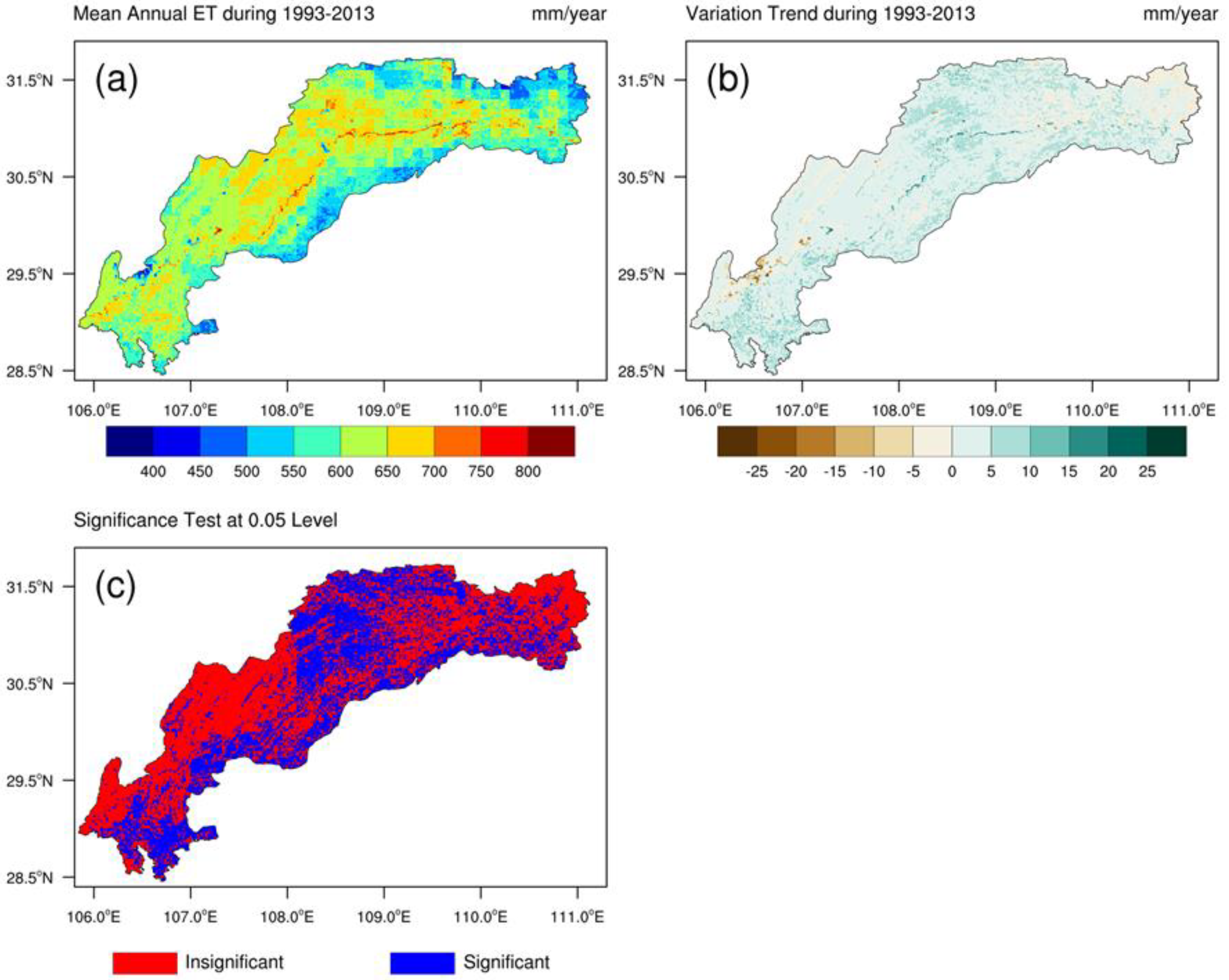



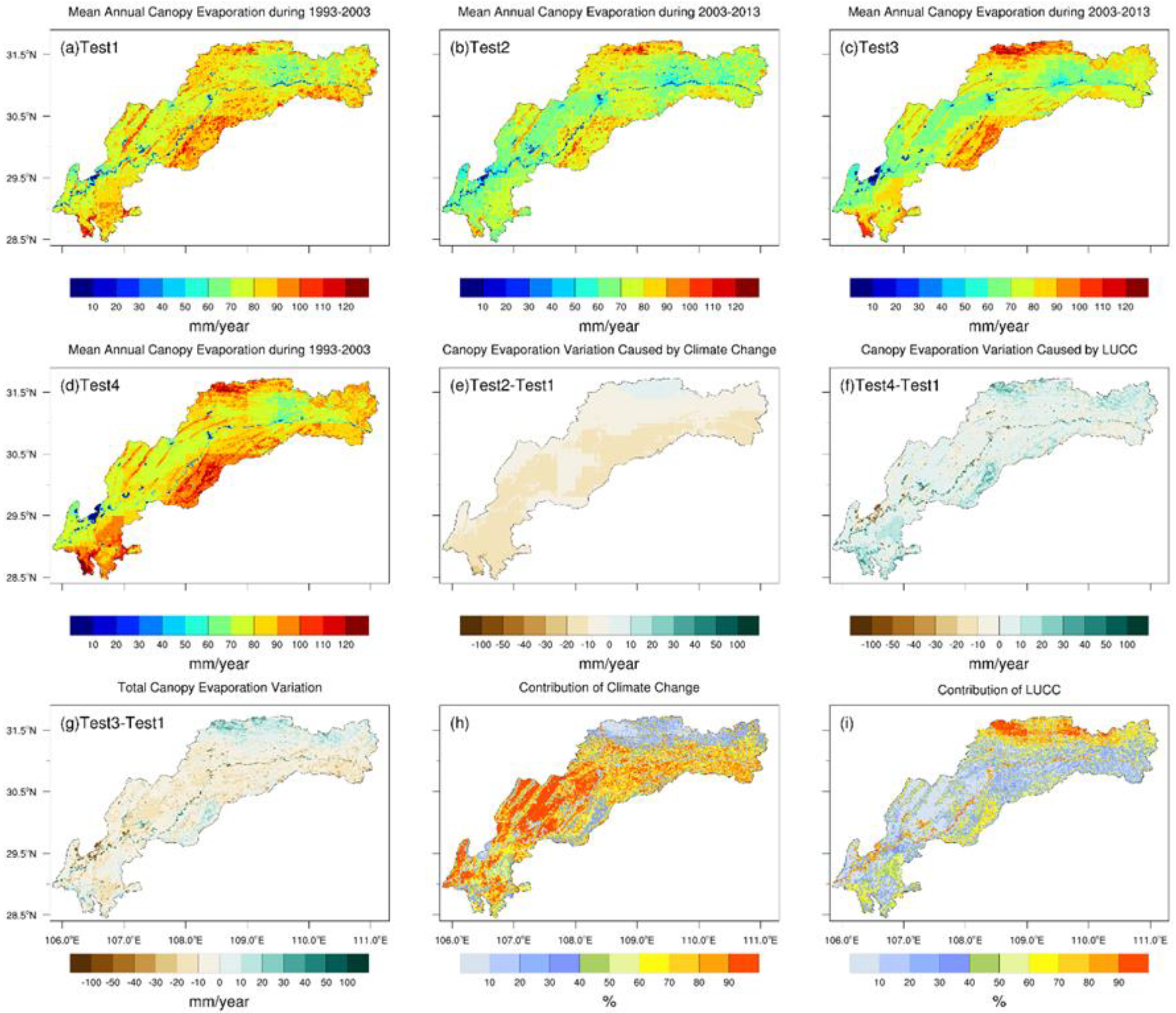

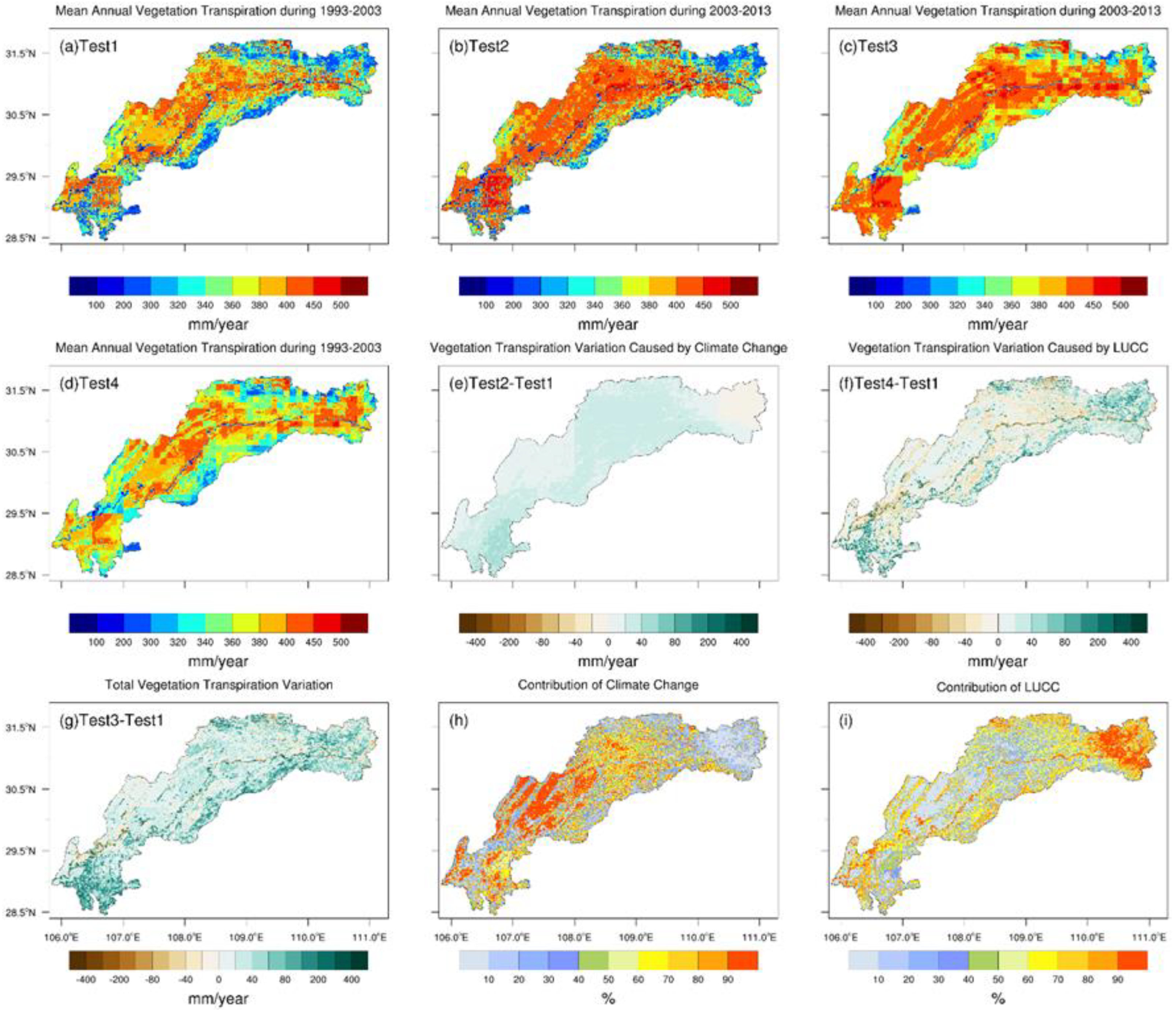
| Test | Atmospheric Forcing | Land Use/Land Cover |
|---|---|---|
| Test 1 | June 1993–May 2003 | 2000 |
| Test 2 | June 2003–May 2013 | 2000 |
| Test 3 | June 2003–May 2013 | 2010 |
| Test 4 | June 1993–May 2003 | 2010 |
| Climatic Factors | Jan | Feb | Mar | Apr | May | Jun | Jul | Aug | Sep | Oct | Nov | Dec |
|---|---|---|---|---|---|---|---|---|---|---|---|---|
| P(mm·a−1) | −0.15 | 0.02 | 0.67 | 0.20 | 1.03 | −2.39 | −3.31 | 0.32 | 2.41 | −1.67 | 0.47 | −0.43 |
| T(°C·a−1) | −0.005 | 0.058 | 0.105 *1 | 0.062 | 0.059 | 0.040 | 0.055 | 0.031 | 0.049 | 0.057 | 0.035 | 0.011 |
| W(m·s−1·a−1) | −0.003 | −0.002 | −0.007 | −0.009 | −0.003 | −0.009 * | −0.006 * | −0.010 * | −0.005 | −0.007 * | −0.004 | −0.0004 |
| RH(%·a−1) | −0.23 * | 0.003 | −0.24 * | −0.18 | −0.09 | −0.09 | −0.13 | −0.07 | −0.07 | −0.003 | 0.02 | −0.16 |
© 2019 by the authors. Licensee MDPI, Basel, Switzerland. This article is an open access article distributed under the terms and conditions of the Creative Commons Attribution (CC BY) license (http://creativecommons.org/licenses/by/4.0/).
Share and Cite
Wang, H.; Xiao, W.; Zhao, Y.; Wang, Y.; Hou, B.; Zhou, Y.; Yang, H.; Zhang, X.; Cui, H. The Spatiotemporal Variability of Evapotranspiration and Its Response to Climate Change and Land Use/Land Cover Change in the Three Gorges Reservoir. Water 2019, 11, 1739. https://doi.org/10.3390/w11091739
Wang H, Xiao W, Zhao Y, Wang Y, Hou B, Zhou Y, Yang H, Zhang X, Cui H. The Spatiotemporal Variability of Evapotranspiration and Its Response to Climate Change and Land Use/Land Cover Change in the Three Gorges Reservoir. Water. 2019; 11(9):1739. https://doi.org/10.3390/w11091739
Chicago/Turabian StyleWang, Hejia, Weihua Xiao, Yong Zhao, Yicheng Wang, Baodeng Hou, Yuyan Zhou, Heng Yang, Xuelei Zhang, and Hao Cui. 2019. "The Spatiotemporal Variability of Evapotranspiration and Its Response to Climate Change and Land Use/Land Cover Change in the Three Gorges Reservoir" Water 11, no. 9: 1739. https://doi.org/10.3390/w11091739
APA StyleWang, H., Xiao, W., Zhao, Y., Wang, Y., Hou, B., Zhou, Y., Yang, H., Zhang, X., & Cui, H. (2019). The Spatiotemporal Variability of Evapotranspiration and Its Response to Climate Change and Land Use/Land Cover Change in the Three Gorges Reservoir. Water, 11(9), 1739. https://doi.org/10.3390/w11091739





